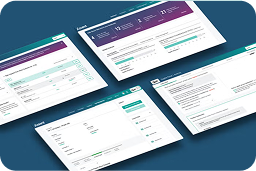Most manufacturers don’t plan to build a Frankensteinian patchwork of compliance tools … but it can happen over time if you’re not looking at the big picture. A reporting tool for the Registration, Evaluation, Authorisation, and Restriction of Chemicals (REACH) Regulation. A critical minerals reporting system. Yet another piece of software for supply chain sustainability data, like Scope 3 emissions. Each one solves a specific problem, but soon enough, the workload of managing siloed data across each point solution becomes time-consuming, prone to errors, and more expensive than you first budgeted for.
Every expanding compliance program made up of individual solutions inevitably hits the same wall: Complexity outgrows the tools meant to control it. That’s why the long-term solution for growing manufacturers is to move toward a single, connected platform that brings everything together.
Understanding Your Product Compliance Software Choices
A point solution is a standalone tool built to solve one specific problem, such as managing REACH compliance. It focuses on collecting only the specific data needed for your compliance report. It works well in isolation but does not reuse the data you already have to support other compliance needs, even if two reports use the same type of supplier data. You don’t get visibility into how your suppliers and parts are interconnected across the broader regulatory landscape.
A platform solution puts data intelligence first and centralizes compliance needs in one system. It collects data from your supply chain, but can interpret that data in multiple ways to support different compliance reports. A platform solution lets you be more productive, too, as teams across your organization get a single source of truth for compliance reporting, product design, risk management, and customer request management.
Why Point Solutions Fall Short as Compliance Grows
Point solutions do one thing well. But as your list of requirements grows alongside your business, these small, separate tools start to create bigger problems. For example, if you expand into a new market, you may need to start submitting data on per- and polyfluoroalkyl substances (PFAS) in your supply chain, ensure your packaging is sustainable, and provide data on forced labor risks in your supply chain to your newest customer.
In that scenario, you’ll need at least three point solutions to meet your requirements. Your suppliers will receive multiple surveys asking for different data each time instead of one comprehensive survey. And that leads to lower supplier engagement, or worse, total supplier fatigue and zero responses. Internally, you’ll be managing data across different databases, validating scattered data, and creating blind spots. All this makes compliance harder, not easier.
And that example only scratches the surface of the regulatory requirements that manufacturers face every day. In the real world, compliance requirements are even more complex: One Assent customer reported a 500% increase in customer compliance inquiries, and that compliance tasks rose from 10% to 60% of their team’s daily workload. With more regulations emerging or evolving every year, disconnected point systems make it impossible to keep pace. Simply put, point solutions cannot scale with your requirements.
How Platform Solutions Outperform Point Every Time
A true platform solution is built on the idea that compliance data should live in one connected system, not scattered across separate tools. Instead of managing REACH in one place, RoHS in another, and sustainability data somewhere else, a platform brings all this information together under a shared model. That means suppliers, materials, and product information are all linked and updated in real time.
At the center of a platform is a single source of truth for supplier and product data. Suppliers only have to use one portal and one process. Each part or material record connects to all relevant regulations. When an updated declaration from a supplier comes in, the platform automatically updates across applicable regulations. This eliminates duplicate work and helps teams identify risks faster.
The Assent Sustainability Platform takes this one step further by combining technology with human expertise. Our regulatory specialists and Managed Services team work alongside the software to engage suppliers, interpret complex rules, and ensure your data is complete and correct. Across industries, companies using Assent’s platform report 2–3X higher productivity compared to competitors and see major reductions in program costs and risk exposure.
“Assent has the platform, in-house expertise, and personal customer service to help us navigate through compliance requirements.” —Justin Zirbes, Project Engineer, Klein Tools
Real Results: Lessons From Prestolite & Ryerson
The value of a platform solution becomes clear when you hear from manufacturers that have made the switch.
After Ryerson, a major metals distributor, established a dedicated compliance team, they realized responding to customer data requests would be a bigger task than they’d expected. Andrea Okun, Deputy General Counsel & Chief Compliance Officer at Ryerson, noted: “As we started tackling it, first you get a couple of questions, then you get 20 questions, and then you realize this could be a full-time job, more than a full-time job. Ten people could do this. And we realized we needed expert assistance.”
Ryerson looked at point solutions to tackle the challenge, but saw the greater ROI of a platform approach that included support and expertise, not only software. Says Andrea: “We did talk to competitors and some other groups, but we really liked the Assent platform. We liked the people we were dealing with.”
Read the Ryerson Success Story Here
Prestolite Electric Incorporated, a global manufacturer of alternators and starters, once relied on a software-only point solution for product compliance. But the Prestolite team wasn’t happy with the results and how little visibility they had into their supply chain risks. “[Before Assent], we didn’t know how much risk we were in,” said Prestolite’s Compliance/EH&S Specialist.
By moving to Assent’s platform, Prestolite gained a centralized compliance database, automated supplier outreach, and expert guidance on REACH and RoHS requirements. The impact was dramatic. Their conflict minerals data coverage jumped from 12% with their old provider to 75% with Assent’s platform.
Read the Prestolite Success Story Here
Across both companies, the story is the same: A platform solution for product compliance management delivers measurable gains because it combines software, data, and expertise. The Assent Sustainability Platform helps organizations simplify complex compliance work, protect market access, and build a stronger foundation for sustainable growth all through one centralized system.
Build for What Comes Next
Compliance leaders face growing pressure from regulators, customers, and investors. Older, disconnected systems might have gotten by in the past, but they cannot handle the pace or scale of today’s product compliance and product sustainability requirements.
Evaluate your current compliance tech stack:
- Which tasks, like data roll-up, analysis, and reporting, are repeated by separate groups?
- Which data is used in multiple places?
- Which vendors, parts, or products are in scope of multiple regulations?
- Is your team finding certain tasks repetitive or frustrating?
You’ll quickly notice where you’re wasting time and money with point solutions.
A supply chain platform, in contrast, gives organizations the clarity to see risks early, the flexibility to adapt quickly, and the insight to make better decisions.
Moving from disparate point solutions to a unified platform is a turning point that will transform compliance from a series of separate tasks into a strategic advantage that strengthens the entire business. Assent can help you make the switch to a cohesive platform. Talk to one of our experts to see where you can uncover the biggest benefits to your compliance program and bottom line.
FAQ: Compliance Platforms vs. Point Solutions
Confused about your supply chain software options? Get the fact with answers from our regulatory experts.








